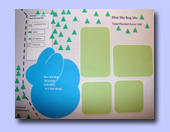|
Lesson Plan:
Overview
Background
Materials
Preparation
Step-by-Step
|
Orient students to their task, resources, and handouts (depending on your grade level, this may take the better part of your first session):
- Tell students that they will be working in pairs to adopt a bog. Their task will be to select a bog from 3 choices (Blue Sky, Liberty, or Sunrise).
- Present the idea that in order to make a good decision, there are certain types of information that students will need to collect. Conduct a class discussion about the types of information they think might be useful.
- Students will first use this interactive table to hear valuable advice regarding the ideal location for a bog, important resources a bog needs, and the type of climate and weather necessary for cranberry plants to thrive. Make sure students understand that they should use the title and header of the table to access the experts.
- Introduce page 1 of the Student Graphic Organizer (SGO), Listening to the Experts. Students use this worksheet to record important points the experts make.
- Tell students that after listening to the experts, they will collect specific information about each bog.
- Introduce page 2 of the SGO, Evaluating the Bogs. Stress to the students the importance of recording all information they learn about each bog. They will use this SGO as a tool for helping them track and evaluate information about each bog they encounter. Point out where to document positive and negative features of each bog.
- Distribute pages 1 and 2 of the SGO to each team. Point out that each column title indicates the types of information they will collect for each bog (location, resources, weather & climate). Encourage students to try out the interactive components by clicking on the links. Allow for ample exploration time.
- As a whole class, address whether there are any questions or confusions with the Give Me the Information table or the SGO. Check to make sure all pairs understand where they can access different types of information and how they will use the SGO.
- Have students begin to gather and record the information from the interactive, Give Me the Information. As they work, and at the end of each session, check in with students, and help them make connections between the expert opinions and the specific bog features.
- Conduct group discussions at the end of the first and second sessions for the whole class to hear ideas that are emerging. Begin keeping a class documentation chart, where students can publicly record their thinking about the positive and negative aspects of each bog. This public forum can elicit good student discussion and critical thinking.
- As student pairs complete their information gathering on the SGO, instruct them to come to a preliminary decision about which bog to adopt and to record that decision at the bottom of their SGO.
- Have student pairs access and review the assessor’s report for the bog they decided to adopt.
Note: Based on the overall data presented to the students, the only viable bog adoptions are Blue Sky and Sunrise. Liberty bog is not a suitable selection because of warm winter temperatures and insufficient water resources. The assessor’s reports do not expressly approve or reject a specific bog to allow for student reflection, conversation, and critical thinking.
- When student pairs have made their final adoption selection, direct them to the Bog Blog, where each student will compose a persuasive article, defending his or her bog decision.
|



